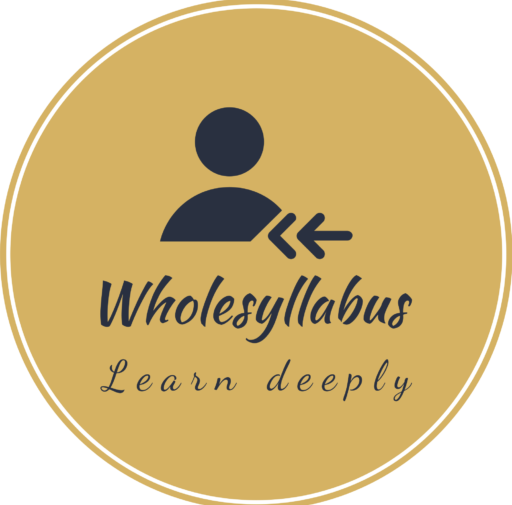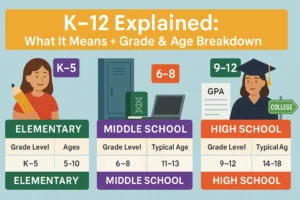You’ve probably heard the term “K–12” tossed around a lot—especially if you’re looking into schools, homeschooling, or online education. But what exactly does it cover? And why is it so important in the U.S. school system?
In this guide, we’ll break everything down:
- What the heck K–12 means
- What ages it covers
- Your options (public, private, online, homeschool)
- And even what parents on Reddit and Quora are saying 👀
So yeah—it’s not just for first-time parents. Even 10th graders ask, “Wait, what’s the difference between K2 and K12?” Let’s get into it.
What Does K–12 Actually Mean?
K–12 is short for Kindergarten through 12th grade.
It’s how the U.S. groups a child’s entire school journey—starting around age 5 and going up to 17 or 18.
You’ll hear this term a lot when people talk about education in the U.S., especially when discussing school programs, policies, or online schooling.
How It’s Broken Down:
- Elementary School – Kindergarten to 5th grade
- Middle School – 6th to 8th grade
- High School – 9th to 12th grade
Each stage builds on the one before it, helping kids grow their reading, math, science, and social skills—step by step.
💬 A parent on Reddit said:
“We moved from Canada to the U.S., and the K–12 system confused me at first. But once I saw how it’s split into elementary, middle, and high school, it clicked.”
Source – r/Parenting
Curious how U.S. schools grade K–12 students? Check out this easy GPA guide →
What Age Are You in K–12? (Simple Chart)
Here’s a quick grade-to-age cheat sheet:
| Grade Level | Typical Age Range |
|---|---|
| Kindergarten | 5–6 |
| 1st – 5th Grade | 6–11 |
| 6th – 8th Grade | 11–14 |
| 9th – 12th Grade | 14–18 |
Want the official word?
Check the U.S. government’s K–12 Education overview on the Department of Education website.
Planning ahead? See what GPA you’ll need to stand out for college admissions. Read: What is Cumulative GPA →
What’s Taught in K–12? (By Grade Group)
K–12 covers more than just years in school — it’s about what students actually learn as they grow up.
K–5: The Building Blocks
This is where it all begins.
- Reading & Phonics – Learning how to read, then reading to learn
- Basic Math – Addition, subtraction, times tables (those sticky 7s!)
- Science – Seasons, animals, cool facts about volcanoes
- Social Studies – Community helpers, holidays, geography
- Art & Play – Drawing, cutting, gluing (and yes, some coloring outside the lines)
A mom on Quora shared:
“My daughter is in 3rd grade and just learned about the water cycle. She came home and made a ‘cloud’ in the microwave. It was chaos, but she remembered the science!”
Source – Quora Parenting Thread
Grades 6–8: The Deep Dive
Now the work gets more serious… but still fun (sometimes).
- Math – Fractions, ratios, intro to algebra
- Writing – Longer essays, book reports
- Science – Cells, weather systems, basic chemistry
- History – Ancient civilizations, U.S. history beginnings
- Health & Tech – Puberty talk, typing skills, digital safety
Students also start switching classrooms and juggling subjects like mini-adults.
Grades 9–12: The Big Leagues
This is the home stretch—where students get ready for college, careers, or life in general.
- Algebra I & II, Geometry, Pre-Calc
- Literature – Analyzing novels, writing essays that take all weekend
- Science Labs – Chemistry explosions (supervised), biology dissections
- History & Civics – U.S. government, world wars, civil rights
- Electives – Art, business, coding, languages, and more
- Test Prep – SAT, ACT, college applications, life decisions 😅
A high school junior on Reddit wrote:
“Junior year is NO JOKE. Between AP Bio and SAT prep, I drink more coffee than my dad.”
Source – r/teenagers
Taking honors or AP classes? Here’s how it affects your GPA. See the difference →
Is K–12 Online School or Homeschooling a Thing?
Absolutely. Online learning and homeschooling have become big options in recent years—especially since the pandemic.
Many families are turning to these choices for more flexibility, personalized learning, or simply because the traditional classroom isn’t the right fit.
What’s the Difference?
- Online K–12 Schools: These are usually run by school districts or private education companies. Students learn from home, but follow a fixed curriculum, take tests, and have real teachers.
- Homeschooling: Parents take charge of what’s taught, how, and when. There’s more freedom here, but also more responsibility.
Popular K–12 Online Programs
- K12.com – Offers tuition-free online public school in many U.S. states.
- Connections Academy – Another well-known tuition-free virtual school program.
- Time4Learning – Great for homeschooling families looking for an organized online curriculum.
A Reddit user shared:
“I did K12 online high school. It wasn’t bad, but you have to be really disciplined. My mom helped a lot.”
— u/zenithshadow on r/homeschool
Thinking of homeschooling? Learn how to self-study and still ace AP exams. Start here →
Public vs Private vs Homeschool vs Online – What’s the Difference?
Not all schools look the same—and they definitely don’t work the same either.
If you’re trying to decide what kind of K–12 education is best for your child (or just curious), here’s a simple breakdown of the 4 main types of schooling in the U.S.
Each has its own pros, challenges, and vibe.
🧾 Quick Breakdown Table
| Type | Free? | Certified Teachers? | Where’s It Taught? |
|---|---|---|---|
| Public | ✅ Yes | ✅ Yes | In your local school district |
| Private | ❌ No | ✅ Usually | In a campus-based setting |
| Homeschool | 🔁 Varies | ❓ Parents often teach | At home |
| Online K–12 | 🔁 Often | ✅ Yes | Anywhere with WiFi |
Quick Explainer
- Public School – Funded by the government. Open to all students. You’re zoned based on your home address.
- Private School – You pay tuition. Often faith-based or specialized. Smaller class sizes.
- Homeschool – Parents (or hired tutors) guide learning. It’s legal in all 50 states but rules vary.
- Online K–12 – Think virtual classrooms. Great for flexibility. Some are public, others private.
Real Parent Experience (from Quora):
“We switched from public to online school during COVID, and honestly—my 8th grader thrived. No bus rides, fewer distractions, and she even got more sleep.”
— Source on Quora
Here’s a clean, simple, and human-friendly side-by-side comparison chart to help parents decide which K–12 school type might fit best—based on real-life concerns like budget, learning style, schedule, and how involved parents need to be.
K–12 School Type Comparison Chart (From a Parent’s POV)
| Factor | Public School | Private School | Homeschool | Online K–12 School |
|---|---|---|---|---|
| Budget | Free (tax-funded) | Can be expensive (tuition, fees) | Depends on curriculum/tools used | Often free (public), or paid (private) |
| Learning Style | Structured, traditional classroom | Structured but can vary by school | Flexible, tailored to child’s pace | Mix of structured + flexible |
| Daily Schedule | Fixed hours (usually 8am–3pm) | Fixed hours, can vary slightly | Completely flexible | Some live classes, but more flexible |
| Parent Role | Low—mostly support with homework | Low to moderate | Very high—parent teaches or guides | Moderate—parents supervise & support |
Real Advice from a Reddit Parent:
“We went with online school after public just wasn’t working for my son. The schedule flexibility made all the difference—especially since he’s a late riser.”
— Reddit Source
Not sure which type of school is right for your child within the K-12 system? Dive into our full comparison of public, private, and homeschool education to weigh the pros and cons.
Do K–12 Rules Change by State?
Yes—K–12 isn’t exactly the same everywhere in the U.S.
Each state gets to make some of its own rules. So, what a student experiences in Texas might be pretty different from a kid in Oregon.
What Can Vary by State?
- School Year Start & End Dates
Some states start school in early August, others wait until September. - Required Tests
State tests can be totally different. One student might take five in a year, while another takes just one. - Graduation Requirements
The number of credits needed to graduate high school? That also depends on where you live.
💬 A Quora user shared:
“Texas requires way more state testing than my cousin’s school in Oregon. It’s wild.”
This flexibility lets states tailor education to their communities—but it can be a bit confusing if you’re moving or comparing schools.
Quick FAQs About K–12 Education
Is K12 considered homeschooling?
Not really. It’s an online public school, so it’s different from traditional homeschooling where parents design the curriculum.
Is K12 actually free?
Yes, in many states. But it depends on your location. Some extras like internet costs or physical materials might not be covered.
What age is K–12?
Kids usually start Kindergarten at age 5 and finish 12th grade by 17 or 18, depending on when they started school or if they repeated a grade.
Is K–12 the same as public school?
Not always. K–12 refers to the grade range. You can attend K–12 in public, private, charter, or even homeschool settings.
Is K–12 considered homeschooling?
Nope, not by default. But you can homeschool your child during their K–12 years. Some families use online programs or state-approved curricula to do this.
Do K–12 students get into college?
Absolutely. If they meet the usual graduation requirements, they can apply to colleges just like anyone else—whether they went to public school, private school, or were homeschooled.
🔗 For official info on graduation and college prep, visit the College Board.
What Should You Do Next?
If you’re a parent, just start by learning what your state offers. If you’re a student—ask questions! Your path can look different than your friend’s.
And yeah, K–12 sounds like a boring label. But it’s where you’ll make friends, learn stuff, and maybe even figure out what to do with your life.
Next Steps:
- Use a grade calculator to track progress
- Look into online options if school’s not working out
- Bookmark this guide 😄

Nawab, an educator teaching K-12 since 2010, holds an English honors graduate degree and a diploma in elementary education. He has also been blogging for five years, sharing insights for educators and parents.

